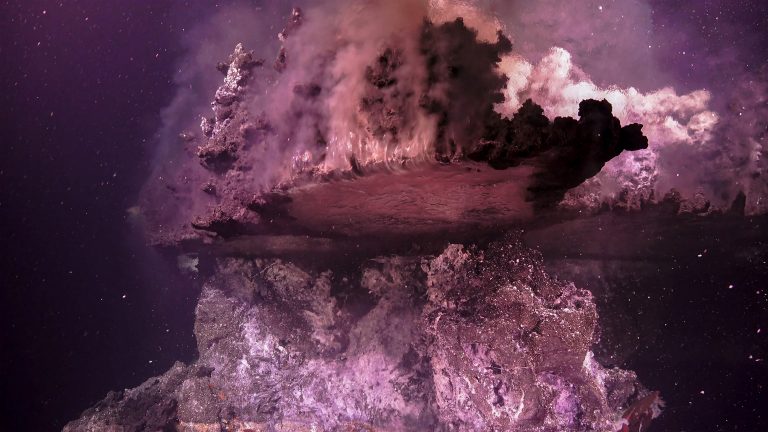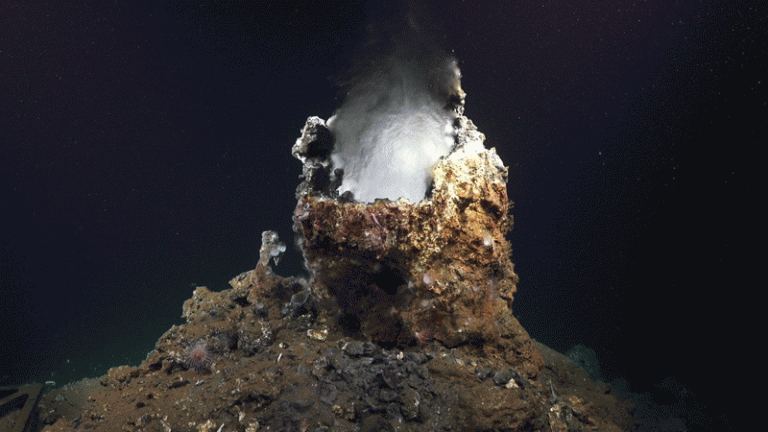One of the most well-known pop-cultural science references comes from the classic 1993 film “Jurassic Park.” Throughout the film a renegade mathematician specializing in chaos theory named Ian Malcolm (played by Jeff Goldblum) says, “Life finds a way.” The statement is true in reality, as well as in fictional worlds where dinosaurs walk among us. Life has found a way to flourish in complete darkness in the deep sea around places known as hydrothermal vents.
Hydrothermal vents were first examined in 1977 near the Galapagos Islands by a team of scientists, including Robert Ballard, the same ocean explorer who found the Titanic. To their amazement, they also found hydrothermal vents surrounded by large numbers of organisms never seen before. Before this discovery, scientists accepted that the deep sea was devoid of life, and all life on planet Earth required the same energy source to proliferate: the Sun. Plants use the sun to create our food through photosynthesis, and without it, we would all cease to survive. Hydrothermal vents proved that is not the case for all species on Earth.

Hydrothermal vents are hot springs or geysers on the ocean floor. Over a 1.5 miles below the ocean’s surface, they are formed in volcanically active areas in the deep sea at the edges of spreading tectonic plates. In these areas, the Earth’s crust can be relatively thin above the mantle. Between the plates, mid-ocean ridges form by magma, pushing the Earth’s crust upward. Just like on land, the seafloor has cracks or “fissures” in them where seawater seeps down inside the planet, and rocks heated by magma, warm this seawater to high temperatures. The heated seawater changes by dissolving minerals, becoming buoyant and a fluid chemically rich in sulfide, methane, manganese, iron, and hydrogen. The fluid travels “up” from the deep crust towards the ocean floor through hydrothermal vents created by the minerals within the fluid, solidifying during contact with the cold seawater. The minerals form into chimneys that act as a geyser (or pipes) for fluid to flow.

Hydrothermal vents have extreme temperatures, toxic minerals, and high pressures. This environment does not sound favorable for life, yet in the darkness observed around these vents are entire ecosystems swarming with life and microbial communities. There is a whole hot spring party happening in the deep sea. Even 2000 meters below sea level, life finds a way, and discovering these hydrothermal vent structures was just the beginning of the story act one, if you will. Life indeed found a way, thanks to chemosynthesis.
Discovering the chemosynthetic process at these deep-sea vents was a game-changer for scientists. Literally. Theories on the origins of life are still developing around these environments. We all need energy, but photosynthesis and chemosynthesis are different processes organisms use to produce that energy. In photosynthesis, plants, algae, and some bacteria convert carbon dioxide and water into carbohydrates using energy from sunlight, leaving oxygen as a by-product. Chemosynthetic processes use the energy released by chemical reactions instead of the sun’s energy, turning inorganic compounds into organic compounds. Microbes like bacteria and archaea do this work.

The marine life thriving around these vents depends on microbes that feed on the chemical energy available in the minerals within the hot fluid, like hydrogen sulfide or methane (or hydrocarbons in the case of the Pescadero Basin). They are the first step in the food chain down there. At the bottom of this food chain, the chemosynthetic bacteria are eaten by larger animals, providing energy for various animals such as tubeworms, crabs, shrimp, mussels, octopus, clams, and fish. These fluid-feeding microbes exist as free-living organisms and live in hosts where both species benefit from symbiotic relationships.
Chemosynthesis might sound like a completely alien process to life on Earth for many of us, but it may be how we all got here in the first place. Studying these environments over the last 40 years has shed light on many mysteries in the deep ocean, and there are many more questions to answer. One question scientists are investigating is the role hydrothermal vents play in the origins of life here on Earth. How did life find a way? Billions of years ago, chemical reactions were happening all over the planet. The atmosphere and ancient oceans formed, and about another billion years later, life evolved. That ancient leap forward from chemistry to biology happened along that timeline, and we do not yet know precisely how. Studying today’s hydrothermal vents and chemosynthetic processes can assist scientists in understanding the possible paths life took to get here and perhaps- where to look first on planets other than our own.
La vida encontró un camino
Una de las referencias científicas más conocidas de la cultura pop proviene de la clásica película de 1993 “Parque Jurásico”. A lo largo de la película, un matemático renegado especializado en la teoría del caos llamado “Ian Malcolm”, interpretado por Jeff Goldblum, dice: “La vida encuentra un camino”. La afirmación es cierta tanto en la realidad como en los mundos de ficción donde los dinosaurios caminan entre nosotros. La vida ha encontrado la manera de florecer en la oscuridad total de las profundidades marinas en torno a lugares conocidos como respiraderos hidrotermales.

Las fuentes hidrotermales fueron examinadas por primera vez en 1977 cerca de las Islas Galápagos por un equipo de científicos, entre ellos Robert Ballard, el mismo explorador oceánico que encontró el Titanic. Para su asombro, también encontraron respiraderos hidrotermales rodeados de un gran número de organismos nunca vistos antes. Antes de este descubrimiento, los científicos aceptaban que las profundidades marinas estaban desprovistas de vida y que toda la vida del planeta Tierra necesitaba la misma fuente de energía para proliferar: el sol. Las plantas utilizan el sol para crear nuestro alimento mediante la fotosíntesis, y sin él, todos dejaríamos de sobrevivir. Los respiraderos hidrotermales demostraron que no es así para todas las especies de la Tierra.

Los respiraderos hidrotermales tienen temperaturas extremas, minerales tóxicos y altas presiones. Este entorno no parece favorable para la vida, sin embargo, en la oscuridad que se observa alrededor de estos respiraderos hay ecosistemas enteros que pululan con vida y comunidades microbianas. Hay toda una fiesta termal en las profundidades del mar. Incluso a 2.000 metros por debajo del nivel del mar, la vida se abre paso, y el descubrimiento de estas estructuras de ventilación hidrotermal fue sólo el comienzo del primer acto de la historia, por así decirlo. La vida encontró un camino, gracias a la quimiosíntesis.
El descubrimiento del proceso de quimiosíntesis en estos respiraderos de aguas profundas supuso un cambio de rumbo para los científicos. Literalmente, las teorías sobre los orígenes de la vida se desarrollan en torno a estos entornos. Todos necesitamos energía, pero la fotosíntesis y la quimiosíntesis son procesos diferentes que los organismos utilizan para producir esa energía. En la fotosíntesis, las plantas, las algas y algunas bacterias convierten el dióxido de carbono y el agua en carbohidratos utilizando la energía de la luz solar, dejando oxígeno como subproducto. Los procesos quimiosintéticos utilizan la energía liberada por las reacciones químicas en lugar de la energía del sol, convirtiendo los compuestos inorgánicos en compuestos orgánicos. Los microbios como las bacterias y las arqueas (las arqueas son como los primos de las bacterias) realizan este trabajo.

La vida marina que prospera alrededor de estos respiraderos depende de los microbios que se alimentan de la energía química disponible en los minerales del fluido caliente, como el sulfuro de hidrógeno o el metano, o los hidrocarburos en el caso de la cuenca Pescadero. Son el primer escalón de la cadena alimentaria allí abajo. En la parte inferior de esta cadena alimentaria, las bacterias quimiosintéticas son consumidas por animales más grandes, proporcionando energía a diversos animales como gusanos tubícolas, cangrejos, camarones, mejillones, pulpos, almejas y peces. Estos microbios que se alimentan de fluidos existen como organismos de vida libre y viven en huéspedes donde ambas especies se benefician de las relaciones simbióticas.
La quimiosíntesis puede sonar como un proceso completamente ajeno a la vida en la Tierra para muchos de nosotros, pero podría ser la forma en que todos llegamos aquí en primer lugar. El estudio de estos entornos en los últimos 40 años ha arrojado luz sobre muchos misterios del océano profundo, y hay muchas más preguntas por responder. Una de las cuestiones que los científicos están investigando es el papel que desempeñan las fuentes hidrotermales en los orígenes de la vida en la Tierra. ¿Cómo se abrió paso la vida? Hace miles de millones de años, las reacciones químicas se producían en todo el planeta. Se formaron la atmósfera y los antiguos océanos y, unos mil millones de años después, la vida evolucionó. Ese antiguo salto de la química a la biología se produjo a lo largo de esa línea de tiempo, y aún no sabemos exactamente cómo. El estudio de las fuentes hidrotermales actuales y de los procesos quimiosintéticos puede ayudar a los científicos a comprender los posibles caminos que siguió la vida para llegar hasta aquí y, tal vez, dónde buscar primero en otros planetas distintos del nuestro.

